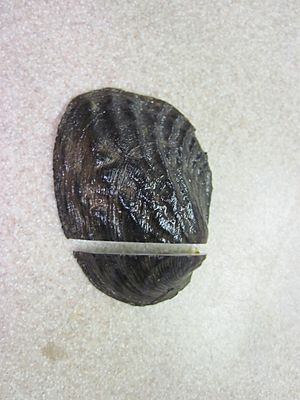Fat threeridge facts for kids
Quick facts for kids Fat threeridge |
|
|---|---|
 |
|
| Conservation status | |
| Scientific classification | |
| Genus: |
Amblema
|
| Species: |
neislerii
|
The fat threeridge (scientific name: Amblema neislerii) is a special kind of freshwater mussel. It lives in the rivers of southern Georgia and Florida in the United States. This mussel is part of a group called Unionidae, which are freshwater mussels.
Fat threeridge mussels like to live in shallow parts of rivers. They prefer areas with muddy or sandy bottoms. Sadly, this mussel is in big trouble. It was first listed as an endangered species in 1998. Now, it is considered critically endangered, which means it's very close to disappearing forever.
Contents
What Does the Fat Threeridge Mussel Look Like?
This mussel is usually quite small. It grows to be less than four inches (about 10 cm) long and also less than four inches wide. Its outer shell is a dark brown or black color.
The inside of its shell is very pretty! It can be bluish-white or even purple. It also has a shiny, iridescent look, like a rainbow. What makes this mussel unique are its shells. They are quite puffy or "inflated." They also have about 7 to 9 strong, parallel ridges (like raised lines) on them.
How Does the Fat Threeridge Mussel Eat?
The fat threeridge mussel is a filter feeder. This means it gets its food by filtering water. It pulls water into its body. Tiny food particles, like bits of plants or other small things, get trapped. The mussel then eats these trapped particles. This way of eating helps keep the river water clean.
Why is the Fat Threeridge Mussel in Danger?
The number of fat threeridge mussels is getting smaller and smaller. There are several reasons why this is happening:
- Not Enough Water: Rivers where these mussels live, especially the Apalachicola-Chattahoochee-Flint River system, are facing severe droughts. This means there isn't enough water, which destroys the mussels' homes.
- Pollution: Trash and chemicals from people and factories along the rivers make the water dirty. This pollution harms the mussels and makes it hard for them to survive.
- Missing Host Fish: Mussels often need certain fish to help their babies grow. If these "host fish" disappear, the mussels cannot reproduce successfully.
- New Animals: Other animals, like the Asian Clam, have been brought into these rivers. These new clams compete with the fat threeridge mussels for food and space, making it harder for the native mussels to thrive.
This mussel has not received much attention. Its dark shell helps it blend in with the muddy river bottom. Also, it does not move around much. Even being listed as an endangered species did not bring it a lot of public notice.
See also
 In Spanish: Amblema neislerii para niños
In Spanish: Amblema neislerii para niños


